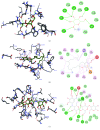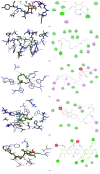GC-MS Analysis and Inhibitory Evaluation of Terminalia catappa Leaf Extracts on Major Enzymes Linked to Diabetes
- PMID: 31662777
- PMCID: PMC6748200
- DOI: 10.1155/2019/6316231
GC-MS Analysis and Inhibitory Evaluation of Terminalia catappa Leaf Extracts on Major Enzymes Linked to Diabetes
Abstract
Terminalia catappa leaves are used in managing both diabetes mellitus and its complications in Southwest Nigeria. However, its inhibitory activity on enzymes implicated in diabetes is not very clear. This study investigated the in vitro inhibitory properties and mode of inhibition of T. catappa leaf extracts on enzymes associated with diabetes. The study also identified some bioactive compounds as well as their molecular interaction in the binding pocket of these enzymes. Standard enzyme inhibition and kinetics assays were performed to determine the inhibitory effects of aqueous extract (TCA) and ethanol extract (TCE) of T. catappa leaves on α-glucosidase and α-amylase activities. The phytoconstituents of TCA and TCE were determined using GC-MS. Molecular docking of the phytocompounds was performed using Autodock Vina. TCA and TCE were the most potent inhibitors of α-glucosidase (IC50 = 3.28 ± 0.47 mg/mL) and α-amylase (IC50 = 0.24 ± 0.08 mg/mL), respectively. Both extracts displayed a mixed mode of inhibition on α-amylase activity, while mixed and noncompetitive modes of inhibition were demonstrated by TCA and TCE, respectively, on α-glucosidase activity. The GC-MS analytic chromatogram revealed the presence of 24 and 22 compounds in TCE and TCA, respectively, which were identified mainly as phenolic compounds, terpenes/terpenoids, fatty acids, and other phytochemicals. The selected compounds exhibited favourable interactions with the enzymes compared with acarbose. Overall, the inhibitory effect of T. catappa on α-amylase and α-glucosidase may be ascribed to the synergistic action of its rich phenolic and terpene composition giving credence to the hypoglycaemic nature of T. catappa leaves.
Copyright © 2019 Franklyn Nonso Iheagwam et al.
Conflict of interest statement
The authors declare that there are no conflicts of interest regarding the publication of this paper.
Figures









Similar articles
-
Linking the Phytochemicals and the α-Glucosidase and α-Amylase Enzyme Inhibitory Effects of Nigella sativa Seed Extracts.Foods. 2021 Aug 6;10(8):1818. doi: 10.3390/foods10081818. Foods. 2021. PMID: 34441595 Free PMC article.
-
Antioxidant, α-Amylase and α-Glucosidase Inhibitory Activities and Potential Constituents of Canarium tramdenum Bark.Molecules. 2019 Feb 9;24(3):605. doi: 10.3390/molecules24030605. Molecules. 2019. PMID: 30744084 Free PMC article.
-
Antimicrobial activity of Terminalia catappa brown leaf extracts against Staphylococcus aureus ATCC 25923 and Pseudomonas aeruginosa ATCC 27853.F1000Res. 2018 Sep 4;7:1406. doi: 10.12688/f1000research.15998.1. eCollection 2018. F1000Res. 2018. PMID: 30416716 Free PMC article.
-
Proposed mechanisms of Terminalia catappa in hyperglycaemia and associated diabetic complications.J Pharm Pharmacol. 2017 Feb;69(2):123-134. doi: 10.1111/jphp.12676. Epub 2016 Dec 20. J Pharm Pharmacol. 2017. PMID: 28000229 Review.
-
An updated review of Terminalia catappa.Pharmacogn Rev. 2015 Jul-Dec;9(18):93-8. doi: 10.4103/0973-7847.162103. Pharmacogn Rev. 2015. PMID: 26392705 Review.
Cited by
-
Counteractive role of Terminalia catappa leaf extract on hematological and coagulation disturbance in Type 2 diabetic rats.Vet World. 2023 Aug;16(8):1593-1599. doi: 10.14202/vetworld.2023.1593-1599. Epub 2023 Aug 11. Vet World. 2023. PMID: 37766705 Free PMC article.
-
Terminalia catappa Extract Palliates Redox Imbalance and Inflammation in Diabetic Rats by Upregulating Nrf-2 Gene.Int J Inflam. 2021 Dec 16;2021:9778486. doi: 10.1155/2021/9778486. eCollection 2021. Int J Inflam. 2021. PMID: 34956587 Free PMC article.
-
α-Amylase and dipeptidyl peptidase-4 (DPP-4) inhibitory effects of Melicope latifolia bark extracts and identification of bioactive constituents using in vitro and in silico approaches.Pharm Biol. 2021 Dec;59(1):964-973. doi: 10.1080/13880209.2021.1948065. Pharm Biol. 2021. PMID: 34347568 Free PMC article.
-
In Vitro Experimental Assessment of Ethanolic Extract of Moringa oleifera Leaves as an α-Amylase and α-Lipase Inhibitor.Biochem Res Int. 2022 Dec 29;2022:4613109. doi: 10.1155/2022/4613109. eCollection 2022. Biochem Res Int. 2022. PMID: 36620201 Free PMC article.
-
Structural Transformation and Creativity Induced by Biological Agents during Fermentation of Edible Nuts from Terminalia catappa.Molecules. 2021 Sep 28;26(19):5874. doi: 10.3390/molecules26195874. Molecules. 2021. PMID: 34641422 Free PMC article.
References
-
- International Diabetes Federation. IDF Diabetes Atlas. 8th. Brussels, Belgium: International Diabetes Federation; 2017. http://www.diabetesatlas.org. - PubMed
LinkOut - more resources
Full Text Sources
Miscellaneous

